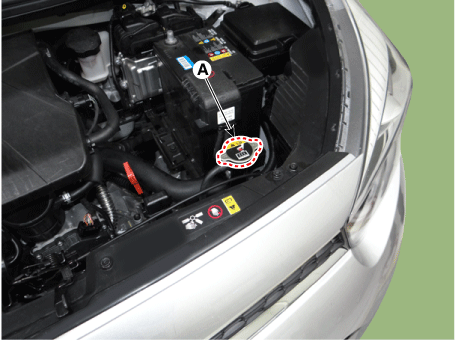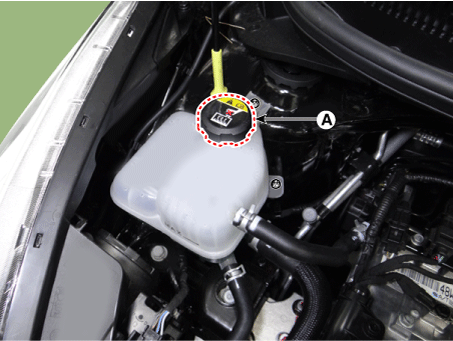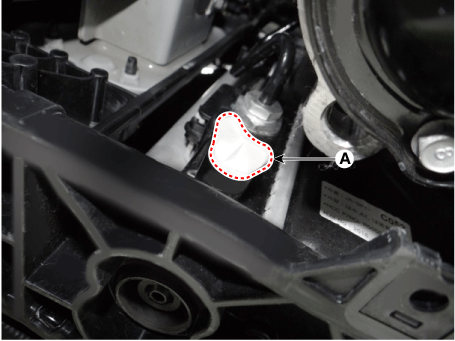Kia Picanto: Power Train / Cooling System
Repair procedures
| Inspection |
Radiator hoses
| 1. | Check radiator hoses for the following
|
Coolant level
| 1. | Check the coolant level in the coolant reservoir. Make sure it is between the "F" mark and "L" mark. |
| 2. | If
the coolant level in the coolant reservoir is at or below the "L" mark,
add coolant to bring it between the "L" and "F" marks, then inspect the
cooling system for leaks. |
Coolant quality
| 1. | Remove the pressure cap. |
| 2. | Check
if there are any excessive deposits of rust or scale around the
pressure cap sub-assembly and radiator filler hole. Also, the coolant
should be free of oil. If excessively dirty, clean the coolant passage and replace the coolant. |
| 3. | Install the pressure cap. |
| Replacement And Air Bleeding |
Never
remove the radiator cap when the engine is hot. Serious scalding
could be caused by hot fluid under high pressure escaping from the
radiator. |
When
pouring engine coolant, be sure to shut the relay box lid and not to
let coolant spill on the electrical parts or the paint. If any coolant
spills, rinse it off immediately. |
| 1. | Make sure the engine and radiator are cool to the touch. |
| 2. | Remove the radiator cap (A). [Kappa 1.0 MPI, 1.2 MPI, 1.0 FFV]
[Kappa 1.0 T-GDI]
|
| 3. | Remove the engine room under cover.
(Refer to Engine Mechanical System - "Engine Room Under Cover")
|
| 4. | Loosen the drain plug (A), and drain the coolant.
|
| 5. | Tighten the radiator drain plug securely. |
| 6. | Remove,
drain and reinstall the reservoir. Fill the tank halfway to the MAX
mark with water, then up to the MAX mark with antifreeze. |
| 7. | Fill the radiator with water through the pressure cap and tighten the cap.
|
| 8. | Start
the engine and allow to come to normal operating temperature. Wait for
the cooling fans to turn on several times. Accelerate the engine to aid
in purging trapped air. Shut engine off. |
| 9. | Wait until the engine is cool. |
| 10. | Repeat steps 1 to 8 until the drained water runs clear. |
| 11. | Fill
fluid mixture of coolant and water (45 - 60%) (except for North
America, Europe and China : 45 - 50%) slowly through the radiator cap. Push the upper / lower hoses of the radiator so as to bleed air easily.
|
| 12. | Start the engine and let coolant to circulate. |
| 13. | When the cooling fan operates and coolant circulates, refill coolant through the radiator cap. |
| 14. | Repeat step 11 until the cooling fan operates 3-5 times and bleed air sufficiently out of the cooling system. |
| 15. | Install the pressure cap and fill the reservoir tank to the "MAX"(or "F") line (A) with coolant. |
| 16. | Run the vehicle under idle until the cooling fan operates 2 - 3 times. |
| 17. | Stop the engine and wait for coolant to cool down. |
| 18. | Repeat 10 to 15 to bleed air out of the cooling system until the coolant level doesn't fall any more.
|
 Battery
Battery
Repair procedures
Inspection
Battery Voltage and Status
Check the battery voltage and status using the battery tester.
Battery Terminal
1. Move back and forth to check that the battery term ...
 Drive Belt
Drive Belt
Repair procedures
Inspection
1.Check belt for maintenance and abnormal wear of V-ribbed part. Replace if necessary.
•
Do not bend, twist or t ...
Other information:
Kia Picanto JA 2017-2025 Service & Repair Manual: Air Cleaner Filter
Repair procedures Inspection 1. Remove the air cleaner element. 2. Check that the air filter is excessively dirty. If the air filter is excessively dirty, replace the air cleaner element. 3. If the air cleaner element needs to be cleaned, blow compressed air as shown in the illustration t ...
Kia Picanto JA 2017-2025 Service & Repair Manual: Airbag Module Disposal
Description and operation Airbag Disposal Special tool required Deployment tool 0957A-34100A Before scrapping any airbags or side airbags (including those in a whole vehicle to be scrapped), the airbags or side airbags must be deployed. If the vehicle is still within the warranty pe ...
Copyright © www.kpicanto.com 2017-2025







